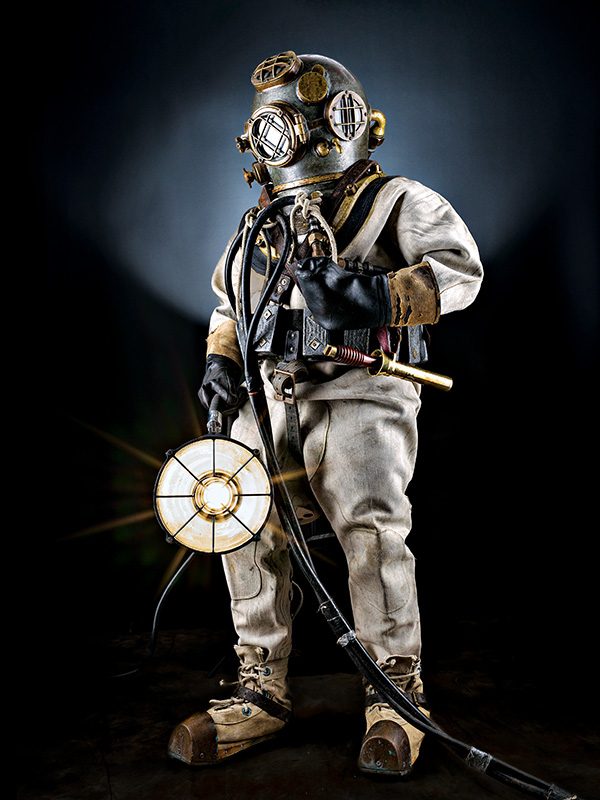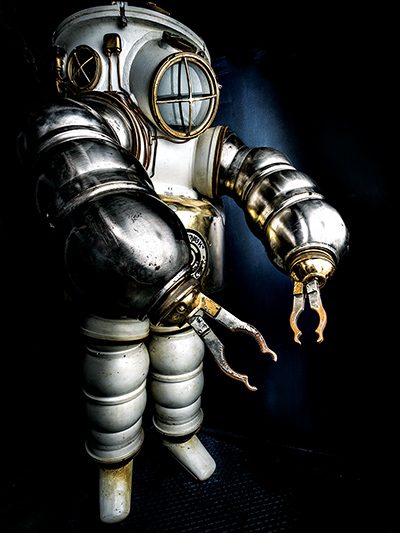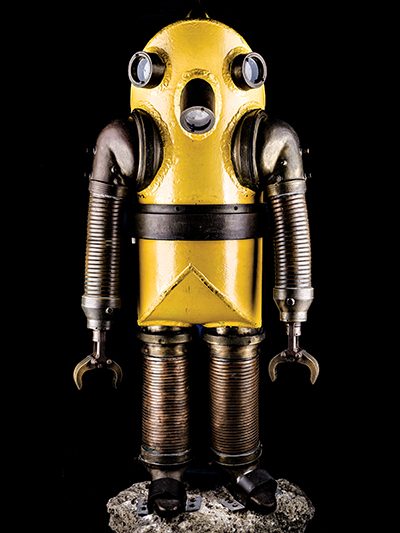L'INCONNU A TOUJOURS ÉTÉ UN TERRAIN FERTILE for mythology, and the oceans have long inspired legends and tales of gods and monsters. From Neptune and Poseidon to Jules Verne, the Kraken, Atlantis, and Namor’s undersea Maya kingdom, Talokan (recently portrayed in La Panthère Noire : Wakanda Forever), the oceans have led us to dream and sparked our sense of wonder. But alongside the oceans’ mysterious unknown is something tangible and real to inspire us and take hold of our imaginations: diving.

For many people, diving brings to mind an image of the average recreational diver with a standard mask, snorkel, fins, and regulator. Yet there is far more to humanity’s subaquatic ventures than this commonplace equipment — the history of diving is filled with an array of oddities and eccentricities that wouldn’t be out of place in science fiction. This fascinating universe has captured my interest for many years and recently compelled me to begin the Diver Project.
To kick off the project, I visited the History of Diving Museum in the Florida Keys. I had found the museum by accident several years ago while visiting my brother and sister in Islamorada, Florida. While driving along the highway on our way to dinner, I was drawn in by the unusual signage on the building, which featured a large Mark V dive helmet and an impressive underwater mural. “We are going there,” I barked at my siblings.


L'intérieur du musée était une corne d'abondance de gadgets étranges et d'équipements bizarres que j'espérais photographier dans le cadre de mon projet, ce qui m'a donné l'inspiration dont j'avais besoin pour commencer. Je suis retourné au musée en février 2023 et j'ai commencé à photographier le merveilleux éventail de casques et de combinaisons de plongée atmosphériques exposés.
The museum’s helmet collection is truly remarkable. The photos with this article are only a small fraction of what I’ve captured on camera, and what I’ve photographed is just a tiny portion of the museum’s vast collection. I’m sharing some of my personal favorites, beginning with helmets the Deane Brothers designed for firefighters.
Renowned for their firefighting helmets in the early 19th century, the Deane Brothers later realized that their innovative design could be adapted for diving. As I perused the museum’s collection, I was amazed to see some of these early dive helmet reproductions on display, including the first commercially manufactured dive helmet from 1832.


Another favorite from the museum’s collection is Iron Mike. Whenever I show it to people, they always seem to have the same reaction: “Hey, that looks like a Minion!” But don’t let its cute appearance fool you — this dive suit was a workhorse. Designed by Thomas Connelly of the Empire Marine Salvage and Engineering Corporation of New York in the early 1930s, the suit was truly ahead of its time. What made the Iron Mike suit so innovative was its use of a metal alloy in its construction. Oher dive suits of the time were typically made of copper or brass, but the Iron Mike suit was made of a lightweight and durable bronze and steel alloy that allowed it to withstand the intense pressure of deep water. Ironically, however, there is no iron in Iron Mike.
The deep-sea Galeazzi atmospheric dive suit (ADS), developed by Italian engineer Roberto Galeazzi in the 1930s, allowed divers to descend to depths of up to 300 meters (984 feet) and stay underwater for extended periods. What’s truly remarkable about the Galeazzi ADS is its unique articulated joint system, which enabled divers to freely move their arms and legs while exploring the depths. The suit was made of cast aluminum and was completely airtight, allowing it to maintain its shape and structural integrity even under the most extreme pressure.

My favorite image from my time at the museum is a portrait I took with the help of the museum’s executive director, Lisa Mongelia, and her friend Sharky, who worked at a local dive shop. Sharky had recently invested in a full Mark V suit and was enthusiastic about having his new suit photographed for the project.
I captured some photos of both Sharky and his friend, Les Burke, posing in the suit. Burke was a Navy diver and one of Carl Brashear’s trainees. Brashear was the U.S. Navy’s first African-American master diver and was immortalized in the film Hommes d'honneur, starring Robert DeNiro and Cuba Gooding Jr. Burke hadn’t worn the Mark V suit since he retired from the Navy, so it was meaningful for him to put it on once again.
Divers revere the Mark V dive helmet, which is the most widely recognized — and collected — dive helmet. Capturing a good shot of a diver in the Mark V suit, complete with the standard-issue Navy dive light, was special to me and epitomized the look I aim to create as I continue to make art that focuses on the world of diving. There is so much to explore, and I’m looking forward to upcoming shoots in California and the Pacific Northwest as well as future trips to Florida and beyond.
Visitez DAN.org pour consulter la liste des opportunités de carrière au siège de DAN. TheDiverProject.com pour see the portfolio. I’m excited to discover where the oddities and eccentricities of diving take me and how I can interpret them photographically. AD
© . - Q2 2023